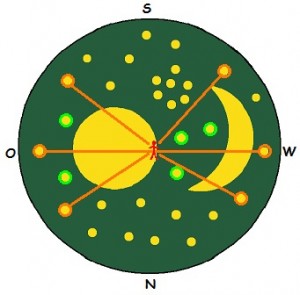If the creator of the Nebra Sky Disc wanted to show that five planets struck him by their movements, too, he would probably place them close to the sun and moon since they are always seen in their paths, as well as within the extreme positions of the ecliptic, which are indicated in this drawing by straight lines.
The five golden stars in the middle of the Sky Disc – marked in green – represent the five planets visible to the naked eye.
Two golden stars can be seen east of the sun on the edge of the horizon. – This facilitates the visibility of the inner planets, Mercury and Venus. Due to the fact that they orbit the sun in their smaller circuits faster than the Earth, they always stand, even at the farthest distance, in the same quarter of the sky with the sun and in the adjacent signs of the zodiac. Looking from the Earth towards the sun, these stars apparently oscillate only around the sun and in so doing always remain near the horizon.
The three other golden planets have been placed between the sun and the moon, closer to the centre of the disc and therefore higher in the sky. – Since the Earth also belongs to the planets and is the third closest planet to the sun, Mars, Jupiter and Saturn go round the sun beyond the Earth’s orbit in wider radii. As we are able to see the paths of these outer planets >from the inside<, they can never stand between us and the sun. Like the sun and the moon, they follow complete orbits in the whole ecliptic. Thus, they can also be found high above the horizon in the south around midnight.
More about this: Die Sterne


